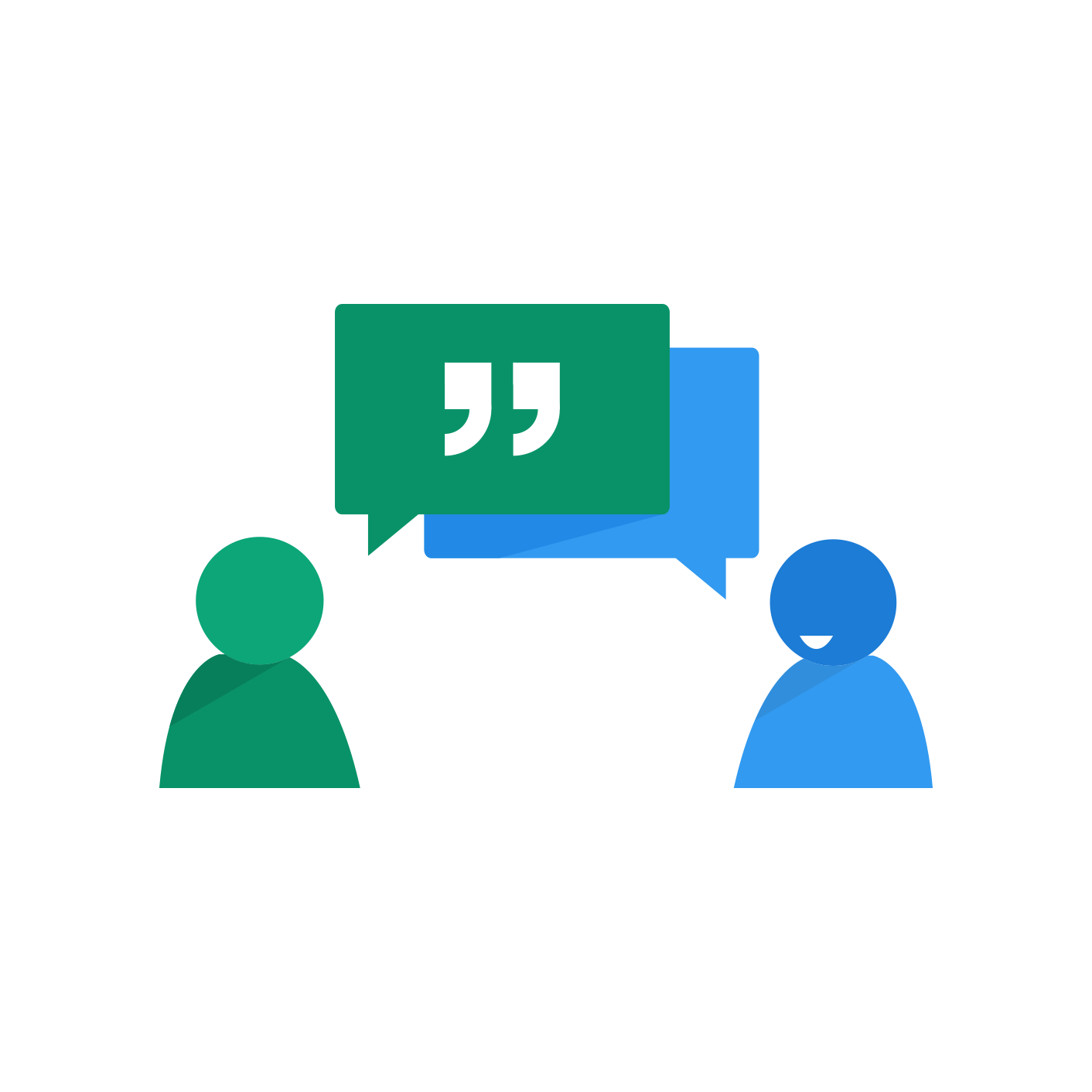 Outreach
Outreach
Promoting awareness and understanding of the facilitator role and of ACI resources to potential users of ACI resources and to various administrators, including entities who exist within and external to the institution. Effectively targeting key audiences.
- Introduction
- Target Audiences
- Publicizing ACI Availability and Usage
- Partnering with Existing Events
- Organizing an ACI Event
5.1 Advertising the Event - Appearing at Events
- Construction of Reusable Materials
7.1 Slide based presentations
7.2 Posters
7.3 Handouts
7.4 Use Case Stories
7.5 Newsletters - Tracking Outreach and Measuring Effectiveness
Introduction
Outreach is a core element of facilitation and is essential to promoting awareness of ACI, including both the physical resources and the expertise of the ACI team to the institutional research community. Outreach can also be used to demonstrate the value these resources bring to an institution and can be used as an opportunity to showcase the ACI available and its use. Whether a Facilitator is part of a well established or a newly formed ACI organization, outreach will be crucial to the growth and long term success of the organization. Outreach goals might include:
- Describe how researchers can obtain access to ACI
- Increase awareness about ACI capabilities
- Discuss the applicability of available ACI solutions to research projects
- Promote the existence and importance of Facilitators
- Demonstrate aspects of facilitation
- Highlight outcomes from the use of the ACI resources
- Demonstrate the return on the investment in ACI resources
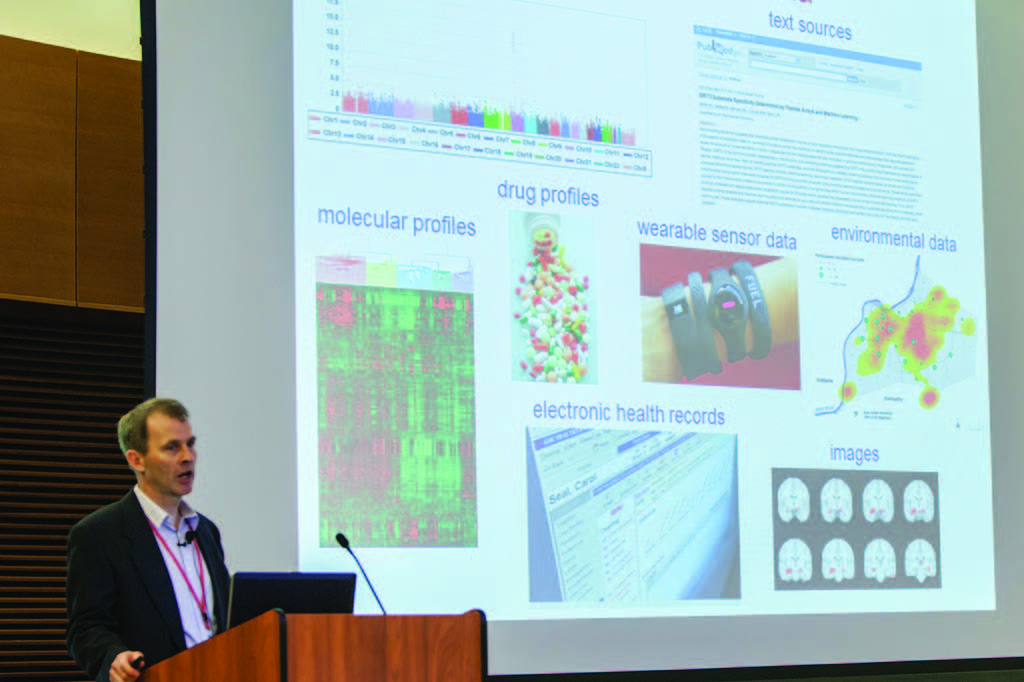 |
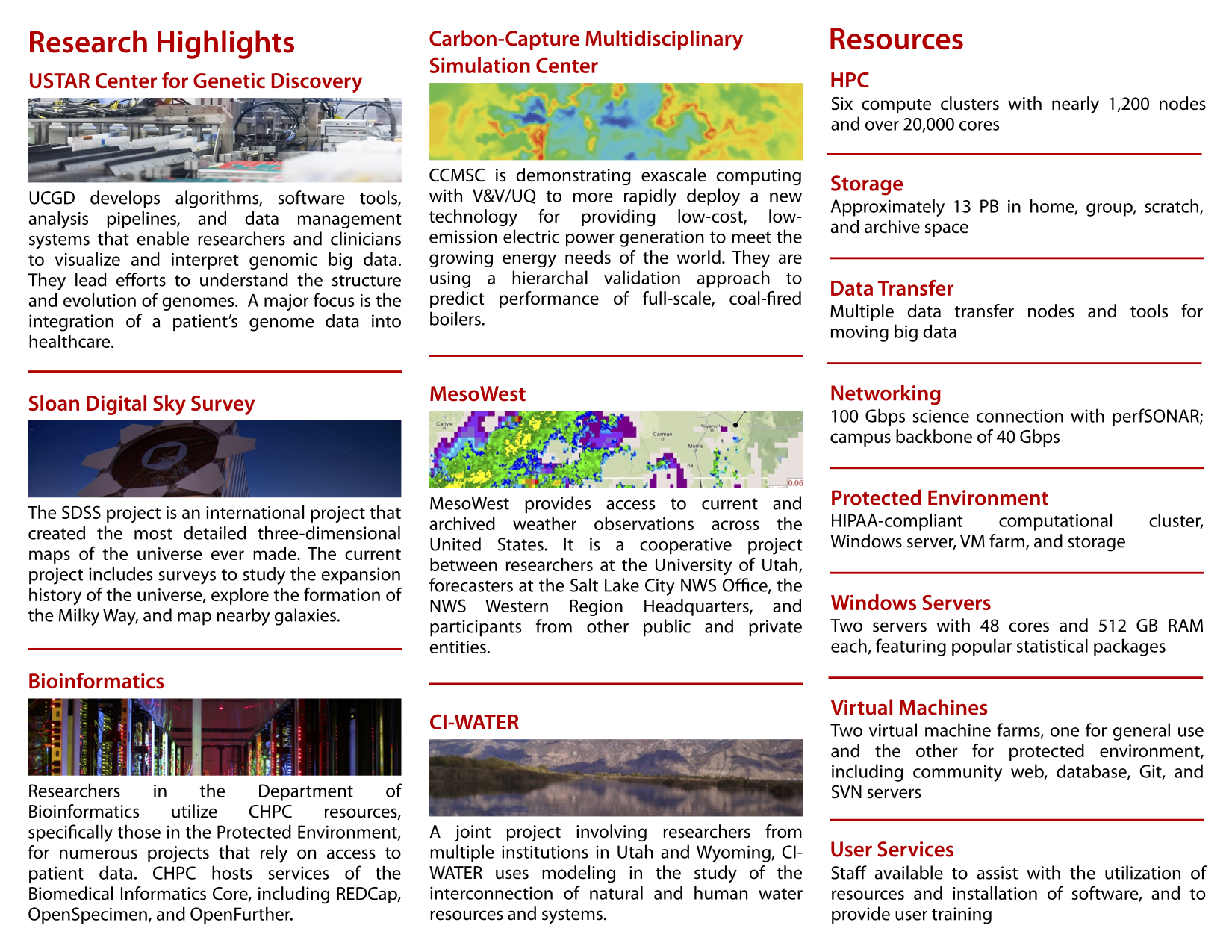 |
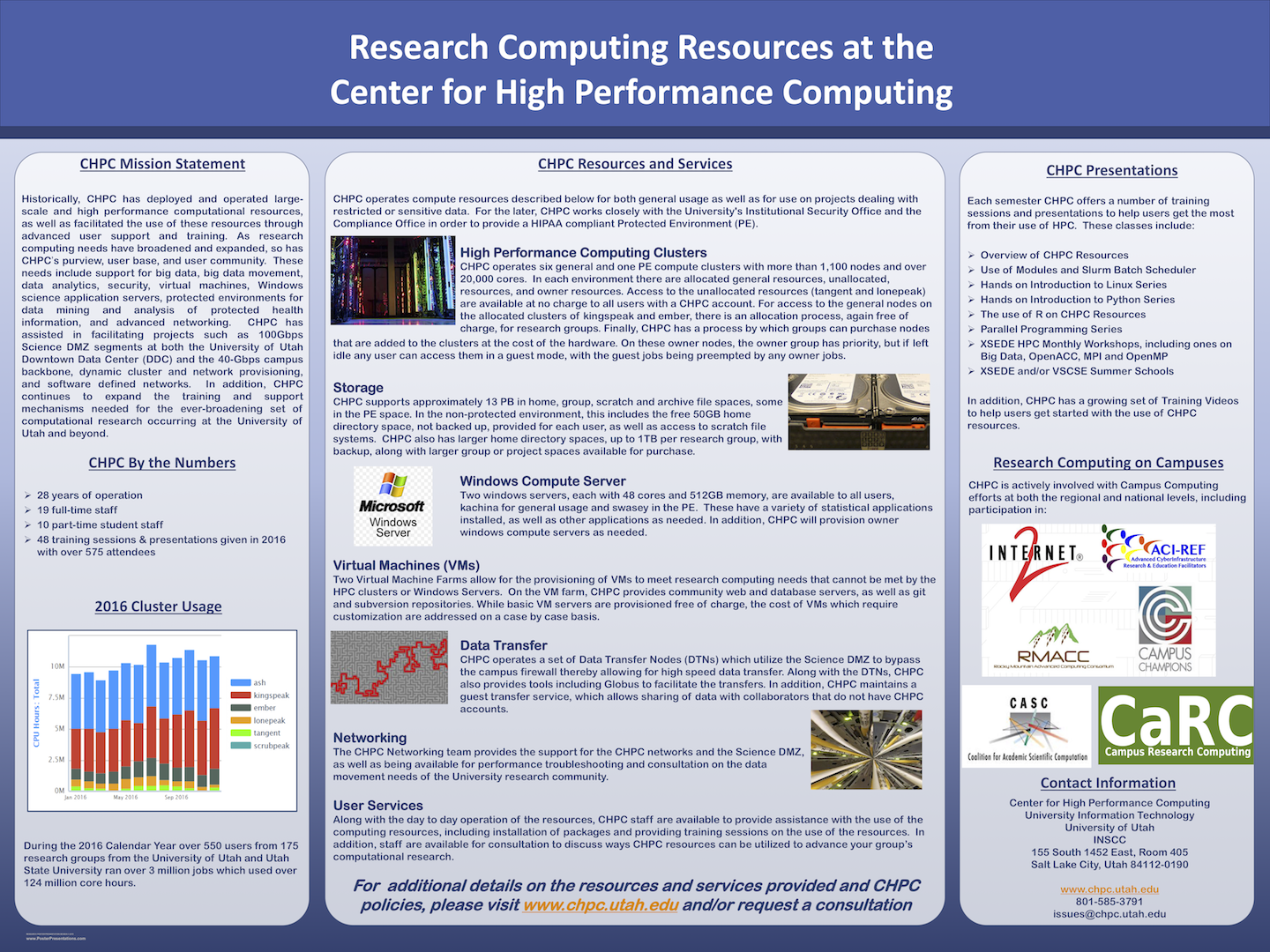 |
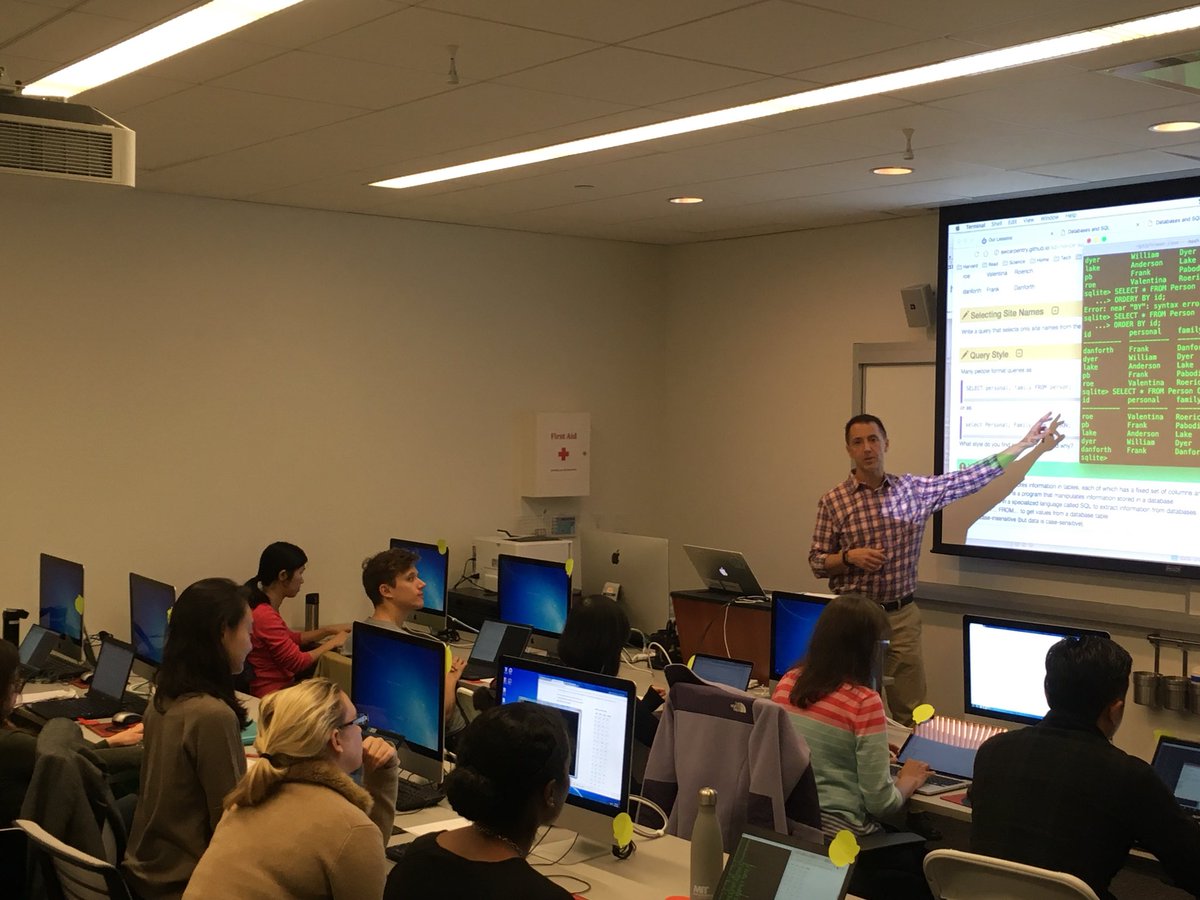 |
There are a variety of outreach avenues, and Facilitators should make themselves aware of the ones available at their institution as well as determining the way to best leverage each depending on the situation and purpose. In this chapter, we will discuss different outreach opportunities, describe ways to convey outreach messages, and provide suggestions on effectively targeting key audiences. The result of effective outreach will result in advocates for the ACI resources among both the researchers and institutional leadership and administration.
Jump to: top
Target Audiences
Outreach for ACI is most often geared towards researchers, including both existing and potential users of ACI. In these cases, outreach will generally revolve around describing ACI resources, including information on user policies and introductions of how to use specific ACI systems, as well as the assistance that a Facilitator and ACI team can provide. As ACI resources evolve over time, especially when the ACI organization is well established, outreach can also be used to inform the user base of changes to available resources, in policies and processes, and in services or staffing, and to showcase the innovation of the organization. Outreach events targeting the research community can also be used as an avenue to obtain information on the evolving needs of the user community.
An institution’s administration and other stakeholders are also an important audience for outreach. ACI is a cornerstone for scientific inquiry and therefore administrators, especially those who make decisions regarding the funding of ACI should be informed regularly about the use of ACI and the value it brings to the institution. This may include the Chief Information Officer, Vice President or Provost of Research, deans, department chairs, and even off-campus entities. Information to communicate will include:
- Use cases that highlight research efforts, especially those that have a high visibility both at the institution and beyond
- Updates on available ACI resources
- Summary data on consultations and training sessions provided to the research community
- Usage of ACI, including measurements of growth and new use cases
 ACI-REFs contribute to a researcher-coordinated computing workshop.
ACI-REFs contribute to a researcher-coordinated computing workshop.
Finally, there may be opportunities to highlight the research successes and use cases of the ACI organization beyond the institution, such as at conferences, cross-institutional communities, and promotional materials. One example is the annual CASC (Coalition of Academic Scientific Computation, casc.org) brochure, which solicits cases to be featured from their member institutions. Participation in conferences such as the annual SuperComputing conference is another way to showcase the usage of ACI resources. Materials for such opportunities may include automated slideshows of highlights, interactive demonstrations of usage, or handouts available at a booth; all are effective ways to provide talking points for people, including Facilitators, manning the booth.
Jump to: top
Publicizing ACI Availability and Usage
Most campuses have a media or communications department that can be utilized to help to promote awareness of the ACI organization. Facilitators should become aware of the communication resources available at their institution and cultivate relationships with the staff of these organizations. The connections to the media and communications staff members can be used not only to inform the research community about resources available, but can also be used to highlight the role that ACI resources played in a any prominent publications. This can be done though the same methods discussed below in the section “Advertising the Event”.
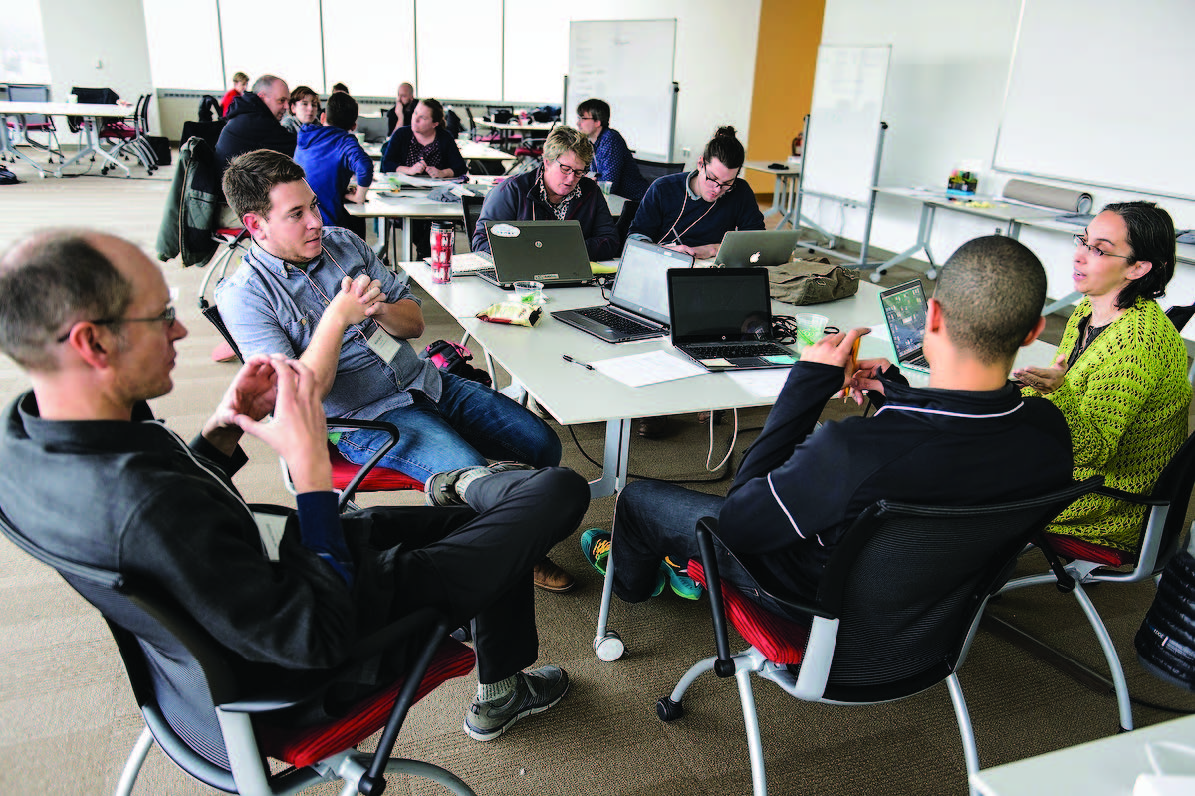 ACI-REFs engage with research grant administrators at the University of Wisconsin.
ACI-REFs engage with research grant administrators at the University of Wisconsin.
Facilitators should take every opportunity to cultivate advocates in different places at an institution. Good advocates are people who have experience with the use of the resources and with the facilitation process; it helps if they have a specific use case on which to speak. These supporters can be used to spread the word about the availability of ACI resources and facilitation, and can be invited to outreach events to help promote ACI. They can also be used to point the Facilitator at additional opportunities for outreach that may exist.
Facilitators should also be aware of other service providers on campus that either provide ACI resources or that make use of ACI resources in their service catalog, and check with them about outreach opportunities. Some examples include:
- At the University of Utah, the USTAR Center for Genomic Discovery (UCGD) is supported by the campus’s centralized research computing provider (CHPC). When the UCGD had a workshop for users of their analysis pipeline, CHPC staff were invited to attend in order to allow the users to meet the provider of computational resources behind the pipeline. Facilitators at events like this one sometimes present information on their ACI organization, but a presence, alone, at these events allows direct and indirect users of ACI resources to put a name and face to the ACI provider and staff.
- At the University of Hawaii, a research group that heavily utilizes the UH ITS Cyberinfrastructure resources is working on mapping the ocean biome invited the Cyberinfrastructure team to attend a research coordination network meeting being held at UH and co-hosted with NSF Earth-Cube. The Facilitators were able to gather information and network with additional UH and collaborating researchers during the event. These connections resulted in a partnership between the community and the ACI team in future grant projects.
- At the University of Wisconsin, Facilitators have met with the campus group of research grant administrators to inform them of campus ACI services, so that these individuals can help researchers to connect with appropriate ACI resources and Facilitators when applying for funding. Beyond outreach events that researchers already attend, Facilitator-like individuals across a variety of ACI and non-ACI campus services regularly meet with each other to stay abreast of resources and facilitate the hand-off of researchers between service providers.
Jump to: top
Partnering with Existing Events
Participating in existing events at an institution can help an ACI organization reach new and diverse audiences, and can be easier than creating an event solely for the purpose of promoting awareness of ACI resources. Thus, researching existing activities at the institutional or departmental levels is a good place to start with outreach. For activities at the division or department level, ask existing ACI users and their ITS or department directors about upcoming or regular events. At the institutional level, check with centers for faculty and research support. For initial contact, reaching out to existing communications groups at any of these levels, can also be a good place to start. Utilizing existing, regularly scheduled meetings such as those discussed below has the distinct advantage that the individuals involved already have the meeting on their calendars and therefore the Facilitator does not have to arrange for a time that works with multiple schedules. In addition, the location of the meeting is also already determined, and therefore there is no requirement to find an suitable location.
For a Facilitator in an academic setting, established events that can be leveraged for outreach include, but are not limited to, faculty candidate visits, new faculty orientation, graduate student orientations, departmental seminars, departmental faculty meetings, graduate or undergraduate seminar classes, and research group meetings. There may also be existing events that specifically showcase research and/or research tools at which a Facilitator may be able to have a table or make a presentation. A Facilitator can also check if there are focus groups on campus and reach out to schedule meetings to explore potential needs for ACI. Another avenue is for a Facilitator to offer to guest lecture in a class that is making use of the ACI resources in order to assist the class as they start to use the resource. A Facilitator can also reach out to instructors of classes covering ACI relevant subject matter that might be interested in having the class here about resources available, even if the resources are not being used for the class. Each of these reaches a different audience, but all are important venues for the successful promotion of the availability of ACI.
Jump to: top
Organizing an ACI Event
Often a Facilitator will be called upon to organize outreach events for their respective ACI organization. There are a multitude of event types that can be effective in promoting ACI and the facilitator role, and the choice of event type depends greatly on the ACI organization and local culture. In this section we will present a number of events that have worked for the institutions involved in creating this document.
 Faculty present the impact of ACI resources at a Research Impact Event organized by
Wisconsin's Center for High Throughput Computing.
Faculty present the impact of ACI resources at a Research Impact Event organized by
Wisconsin's Center for High Throughput Computing.
- Data Center Tours: Tours of the ACI facility can serve as an opportunity to demonstrate to researchers the level of service provided.
- Research Impact Event: Events may be organized to highlight cyberinfrastructure's role in computational research, at which users can showcase their research to one another. A related option is to focus the day on a specific aspect of CI. As an example, Clemson University has run a "GIS Day" to promote GIS resources and GIS based research on campus.
- Seminar Series: This type of outreach can be used to highlight uses of ACI resources and perhaps also lead to collaborations between research efforts. The ACI organization can sponsor periodic seminars that focus on research outcomes obtained with the use of their resources.
- Vendor presentation: These can be used to promote the availability of a specific tool or resource that the ACI provider already has or may acquire. A number of the vendors such as NVidia, Mathworks, and Ansys offer to to hold such events on campuses.
- ACI Resource Announcements: An outreach session can be held in conjunction with the announcement of a new ACI resource or a change in usage and accompanying policy. Facilitators can incorporate additional outreach about pre-existing resources as well.
- Annual User Meetings: An annual meeting or open forum can be scheduled to have a dialog with researchers on the status of the ACI organization and the resources and services provided.
Advertising the Event
The most effective way to promote an event will depend on the desired audience. Consider how the target audience usually receives information about these types of events, and try to leverage existing infrastructure which may include email lists (user base, departments, colleges, other related service providers, etc), web sites, and social media such as Twitter and Facebook. Flyers advertising the event should be physically posted several weeks in advance in different locations, left in reception areas, and emailed to recipients so they can post them in additional locations. As mentioned earlier, campus-level communications units might also assist in promoting the event. Attendance might be motivated for any of the above event types by advertising snacks, swag, or by requiring an RSVP.
Jump to: top
Appearing at Events
As with any time a Facilitator represents their ACI organization, it is important to do so in a professional manner. In many cases, this may be the first interaction that members of the audience have with the ACI organization, so it is essential to make a good impression. Several points to keep in mind when preparing for the event and putting together materials are:
- Be prepared: Arrive early to make sure all is set up properly, especially when using new devices and technologies, or reusing for the first time in a while. Anticipate questions that may come from the audience, and try to address the most important answers in the materials.
- Know the audience: Research the details of the event and design materials accordingly. For events where there will be repeated one on one or one to a small group, such as when manning a booth or a table, prepare an initial "engagement speech" appropriate for the venue.
- Engage the audience: Think about ways to draw in the anticipated audience. It may be worth doing something 'atypical' to draw attention. For example, when manning a booth or a table at a larger event, don't underestimate the value of swag! Depending on the venue, visual materials might include handouts, slide shows of use cases, even live demonstrations using the resources. Be sure to have additional information readily available to address more in-depth questions.
- Provide Contact Information: In all outreach events, as well as materials used in education and training, it is essential to include information on where to get more information and ways to contact the presenter and/or other members of the ACI organization.
Jump to: top
Construction of Reusable Materials
Independent of the target audience and the venue, the goal of any outreach activity is to provide information on the ACI resource and/or to make the audience aware that Facilitators and other staff at from the ACI organization are available to provide assistance. It is very useful to keep a set of current outreach materials that can be reused, or that can at least be the basis for future outreach activities. Some examples of reusable materials are described below.
It is important to make sure that outreach materials are regularly reviewed and updated frequently to ensure that accurate information is provided. For example, updates should be made when there are changes made in the resources, and when new information on usage becomes available.
Slide based presentations
Presentations are generally the most commonly used approach in outreach at most institutions, as they are useful when presenting to a group and as they work in a number of different settings. Typically the larger the audience and the more formal the event is, the more important it is to have a presentation prepared in advance. It is useful to have multiple sets of slides that cover different aspects of the ACI resource or organization, from which to choose depending on the focus of the presentation, the audience, and the time available. An outreach based presentation can be used as a lead-in presentation in an educational and training presentation series, in order to introduce the audience to the resources that will be discussed in future presentations in the series. Alternately it can be a stand-alone presentation given to an group interested in learning more about the ACI resources available and how they are used.
There exist many on-line sources that can be accessed by googling topics such as “pointers for good presentations” or “pointers for effective presentations”. These focus on all aspects of doing a presentation, from determining the content, to creating the slides, to giving the presentation. These sources also include pointers on adjusting presentations to fit the venue, audience, and occasion, as well as tips on how to improve your skill as a presenter.
Posters
 Example poster from the University of Utah's Center for High Performance Computing.
Example poster from the University of Utah's Center for High Performance Computing.
A poster with highlights of either the resources available or a use case, or both, is another valuable tool to use when doing outreach. This can be either a printed poster, or can be a monitor showing a slideshow of use cases and informational materials. While often these are created for an external event, they can also be displayed at the ACI organization, especially when the location is one that is visited by the user base and any visitors to the organization. A Facilitator or any other ACI staff can use these as talking points on the ACI resource and its usage when meeting with either established or new users.
Handouts
One page handouts or brochures are often useful either as stand-alone outreach tools or as supplemental materials for other outreach efforts. When talking to potential or new users, such as new faculty candidates, these can detail the resources available and where to get more information in an easy-to-consume format. The goal is to provide sufficient details on what resources are available and also provide directions to get more information. Alternately, handouts might include facts such as growth in usage, numbers of training event attendees, and/or number of research grants and publications supported; these data can be used effectively to demonstrate the return on investment to administration and other funding stakeholders. In either case, these fact sheets should focus on multiple aspects of ACI, including human support in addition to physical resources.
Use Case Stories
Along with fact sheets, use cases are a very effective outreach tool. These can be short write-ups of success stories made possible due to the availability of ACI resources, especially very visible successes such as those published in high-impact journals or one that have received substantial press coverage. Examples of ACI successes are especially useful when justification the implementation of an ACI resource. Where appropriate, success stories should also feature the role the Facilitators or other ACI staff and can be featured on the ACI organization website.
Newsletters
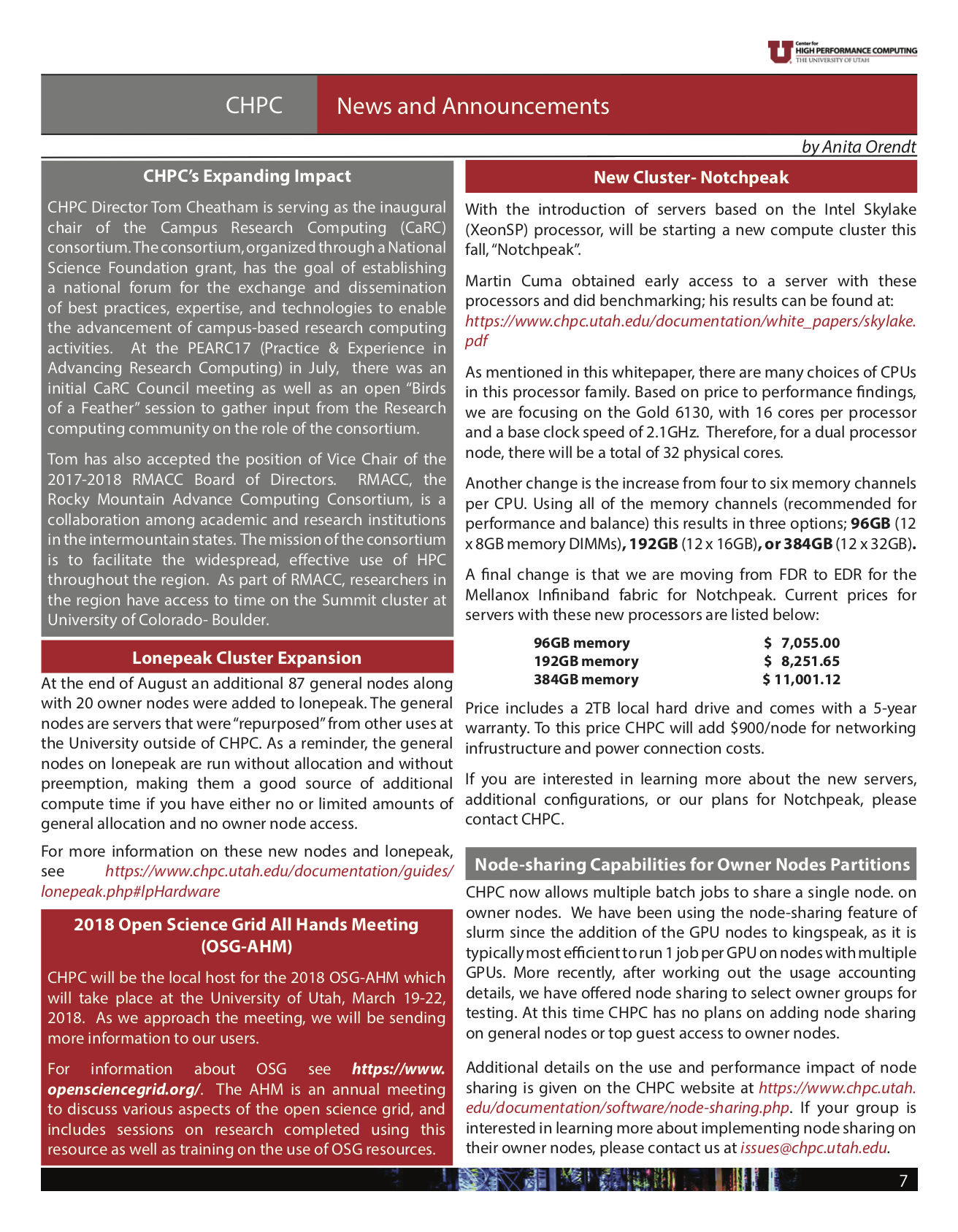 Example page from an ACI resource newsletter.
Example page from an ACI resource newsletter.
Newsletters are another way to present multiple pieces and types of information in a succinct form. These can be produced on a regular schedule and distributed to the users and institutional leadership, via email and/or printed copy. Facilitators can use the distribution of a printed newsletter as a reason to visit with existing users and administration. Any newsletters published should also be made available electronically on the ACI organization website. When providing content, keep in mind that with some topics it is often sufficient to provide a short blurb with a link to a location providing more detailed information, allowing the reader to make a decision if the topic is of interest or applicable to them. As an example, in recent editions of the University of Utah’s Center for High Performance biannual newsletter a section on “What’s new at CHPC” consisting of a series of two or three sentence highlights about items such as minor policy changes, new documentation, growth of resources, and new tools.
Jump to: top
Tracking Outreach and Measuring Effectiveness
While the gathering of metrics and assessment data is discussed in more detail in the chapter on Assessment and Metrics, a few considerations specific to collecting data on outreach activities are presented in this section.
As with other aspects of the Facilitator role, it is important to carefully track various outreach efforts. This involves keeping detailed records of the event, including information such as:
- Date of event
- Location
- Type of event
- Target audience
- Number of attendees
The above information can be used when deciding the value of holding the same or similar events in the future, as well as being a source of information for reporting on various outreach activities. In addition, tools such as Google Analytics can be utilized to assess online advertising methods used and the value of other online outreach content.
Along with recording the metrics of the event, it is also important to get as sense of the effectiveness of the event, in order to determine whether or not the outreach achieved the goal. There are a number of ways to measure the effectiveness, and these are not only applicable to outreach activities, but also to the similar Education and Training activities of a Facilitator. One approach, most valid when the outreach activity is a presentation, is to give the attendees a short written survey. It is best for surveys of this type to be short and easy to complete in order to get the attendees to take the time to complete them.
Along with gathering of metrics at a given outreach event, there are also ways to survey new users regarding how they’ve heard about the relevant ACI resources, including any outreach opportunities they’ve experienced.
Feedback on the effectiveness of an outreach activity can also be obtained by reaching out to one or more of the attendees of the activity, either with a written survey or in a one-on-one meeting. This type of feedback can often provide a higher level of detail, and can be done in an open-ended manner, with the responses to any single question leading to follow up questions and discussion.
Finally, it is essential that the Facilitator take time to reflect upon the outreach activity and record their own observations on the event. Some questions to consider when doing this are:
- Was the outreach activity appropriate for the target audience?
- What part of the outreach did or did not work?
- What should be changed before doing a similar event?
Along with the observations made by the Facilitator themselves, it is also helpful to have a colleague attend the event and offer the same type of feedback as well as a critique. Doing so can provide a different view of the activity. Facilitators and other staff performing outreach should approach this process with an open mind and be prepared to accept any critique as a way to be more effective in future outreach efforts. This can be equally effective for Facilitators who are new to the role as well as more experienced Facilitators who may want to reconsider their normal way of doing outreach.
Whether one of these assessment methods or several are chosen, it is essential that a Facilitator takes the time to carefully consider the feedback and incorporate it in future outreach efforts, both in the planning of future events as well as in the content of the event. Furthermore, this information is valuable to exchange with others that share in the outreach efforts, so that the lessons learned by one individual are not lost and can be used as a learning experience for multiple people.
Jump to: top